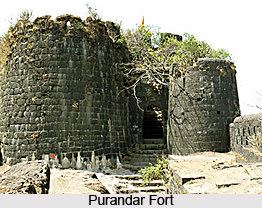 | ||
wikipedia treaty of purandar 1665
The Treaty of Purandar (or पुरंदर चा तह) was signed on June 11, 1665, between the Rajput ruler Jai Singh I, who was commander of the Mughal Empire, and Maratha Chhatrapati Shivaji Maharaj. Shivaji was forced to sign the agreement after Jai Singh besieged Purandar fort. When Shivaji realised that war with the Mughal Empire would only cause damage to the empire and that his men would suffer heavy losses, he chose to make a treaty instead of leaving his men under the Mughals.
Following are the main points of the treaty:
- Shivaji kept twelve forts, along with an area worth an income of 100,000 (1 lakh) huns.
- Shivaji was required to help the Mughals whenever and wherever required.
- Shivaji's son Sambhaji was tasked with the command of a 5,000-strong force under the Mughals.
- If Shivaji wanted to claim the Konkan area under Vijapur's control, he would have to pay 4 million (40 lakh) huns to the Mughals.
- He had to give up his forts at Purandar, Rudramal, Kondhana, Khandagla, Lohagad, Isagad, Tung, Tikona, Rohida fort, Nardurga, Mahuli, Bhandardurga, Palaskhol, Rupgad, Bakhtgad, Morabkhan, Manikgad, Saroopgad, Sakargad, Marakgad, Ankola, Songad, and Maangad.
Along with these requirements, Shivaji agreed to visit Agra to meet Aurangzeb for further political talks.
References
Treaty of Purandar (1665) Wikipedia(Text) CC BY-SA
